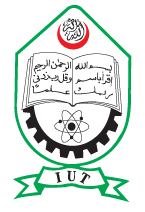Dr. Mohammad Monjurul Ehsan
CO RESEARCHERS:
Mr. Yasin Khan
Mr. Mahdi Hafiz Nabil
Mr. Imrul Kayes
Mr. Muhammad Mahmood Hasan
Mr. Sefat Mahmud Siddique
REQUIRED SKILLS:
a. Programming Skills in C++, MATLAB, Python
b. CAD Skills in Solidworks
c. Computational Fluid Dynamic Software (ANSYS Fluent/Comsol)
d. Thermodynamic Property software, CoolProp
e. System Advisory Model, SAM
f. System Simulation software, EBSILON
RESEARCH AREA
-Power Cycle Modelling
-Advanced Refrigeration
-System Cogeneration/Multigeneration System
-Waste Heat Recovery Design and Optimization of Compact Heat Exchanger
-Machine Learning Optimization
-Heat Transfer with Nanofluid
Power Cycle Modelling
A variety of novel power cycles (steam cycle, Kalina cycle, Organic Rankine Cycle, Supercritical CO2 Cycle, Gas turbine power plant, etc) are modeled by applying the principles of energy and exergy analysis, in accordance with the first and second laws of thermodynamics. These models are developed using computational tools such as Python, EES (Engineering Equation Solver), MATLAB, and EBSILON, among others, to assess and compare the thermal performance of each cycle under different operating conditions. In addition to thermodynamic evaluation, the study also involves a comprehensive exergoeconomic analysis to account for both energy efficiency and associated costs. Furthermore, advanced multi-objective optimization techniques, often integrated with machine learning algorithms, are employed to identify optimal design and operating parameters that balance performance, cost, and sustainability.
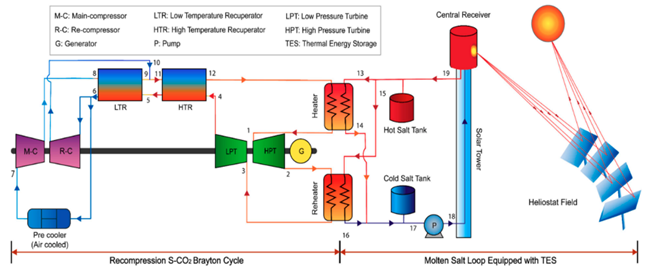

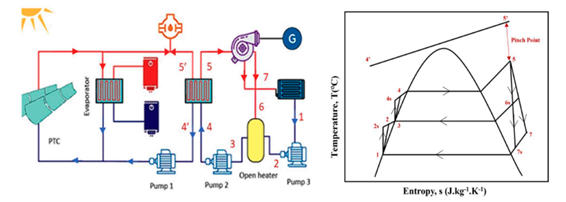
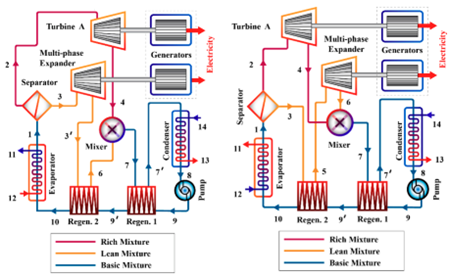
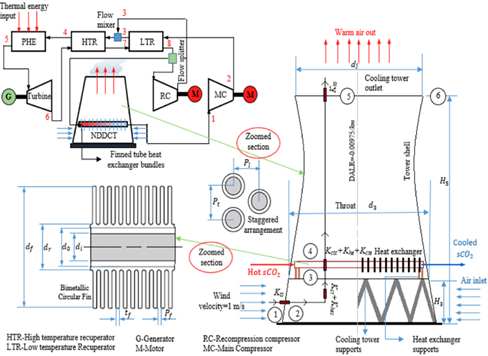
Advanced Refrigeration System
Various advancements are implemented in refrigeration systems to enhance their coefficient of performance (COP). Both conventional vapor compression refrigeration systems and absorption refrigeration systems are modified using a range of enhancement techniques, including flash tanks, suction line heat exchangers, thermal expanders, ejectors, ejector-injection systems, and vortex tubes. In addition, different refrigeration cycles are cascaded to achieve ultra-low temperatures for specialized applications. These advanced refrigeration models are developed using computational tools such as Python, EES (Engineering Equation Solver), MATLAB, and EBSILON, among others. These tools facilitate the assessment and comparison of thermal performance under varying operating conditions. Beyond thermodynamic analysis, the study incorporates comprehensive exergoeconomic evaluations to consider both energy efficiency and economic feasibility. Moreover, advanced multi-objective optimization techniques, often integrated with machine learning algorithms, are employed to determine optimal system configurations that strike a balance between performance, cost, and sustainability.

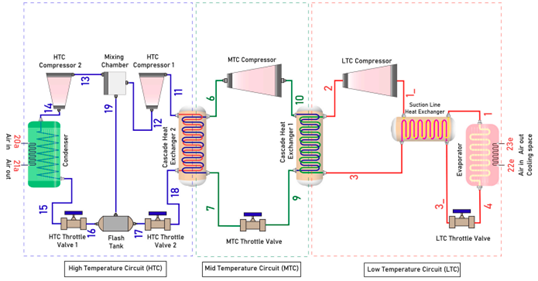
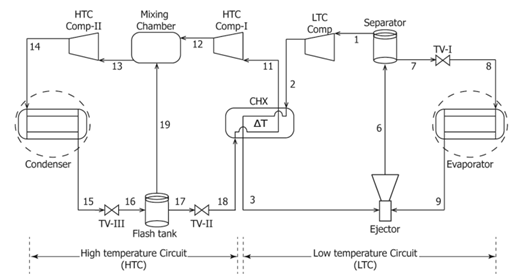
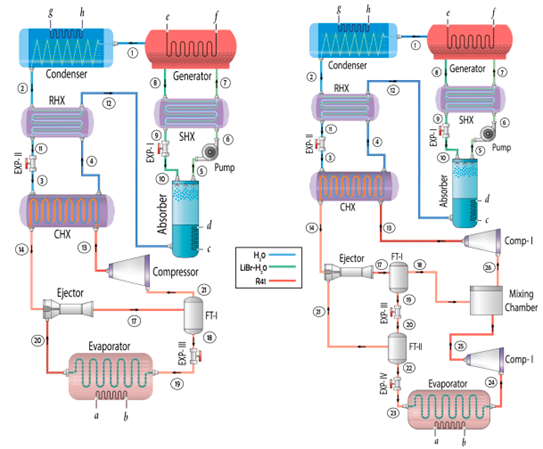
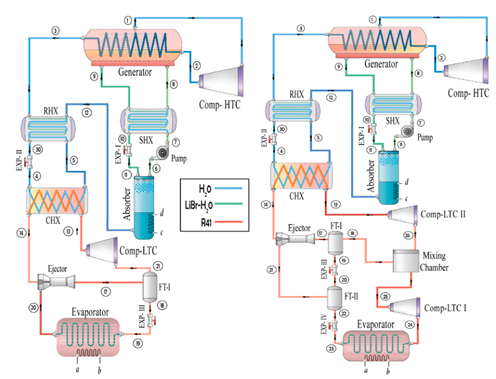
Cogeneration/Multigeneration System
In this research, various types of power cycles and refrigeration systems are integrated to develop novel cogeneration and multigeneration systems. These advanced configurations are designed to simultaneously produce multiple useful outputs, namely electricity, heating, and cooling. Additionally, desalination systems can be incorporated into the multigeneration framework to provide fresh water, further enhancing the overall utility and sustainability of the system. The modeling and analysis of these complex systems go beyond traditional thermodynamic evaluations. A comprehensive exergoeconomic analysis is conducted to assess not only energy efficiency but also the economic viability of the proposed configurations. Furthermore, advanced multi-objective optimization techniques, often leveraging machine learning algorithms, are employed to identify optimal design and operating parameters. These optimization methods aim to achieve a balanced trade-off among performance, cost-effectiveness, and environmental impact, ultimately guiding the development of high-efficiency, sustainable energy systems.

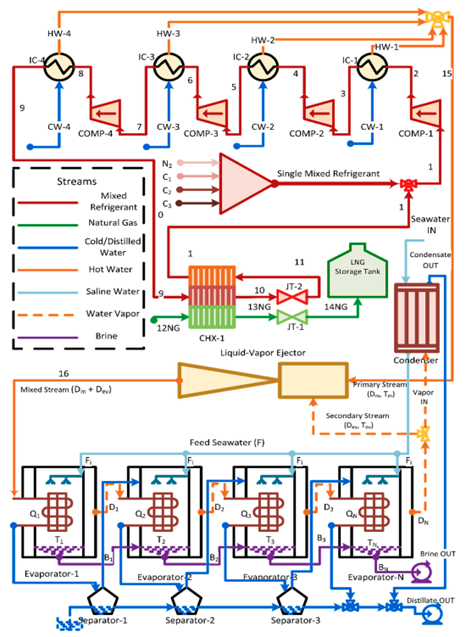
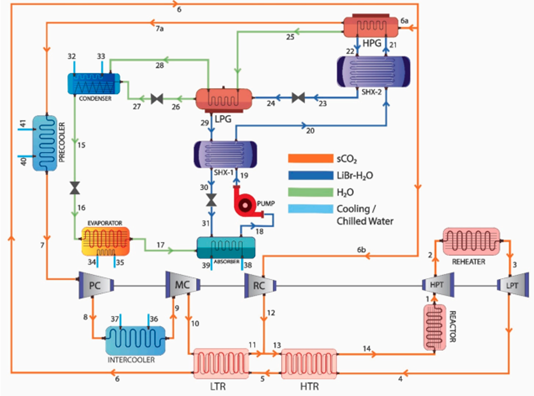
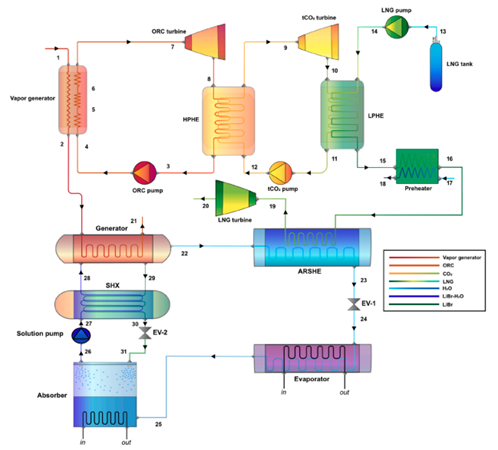
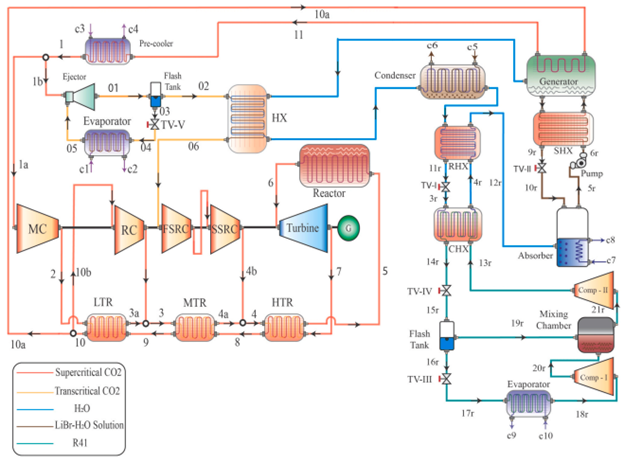
Waste Heat Recovery
Industrial waste heat refers to the energy that is lost, wasted, or discharged into the environment during industrial processes. To harness this untapped energy and enhance overall system efficiency, Waste Heat Recovery (WHR) systems have been developed and implemented across a wide range of industries. These systems offer a valuable opportunity to reclaim and reuse thermal energy that would otherwise be discarded.To reduce overall energy consumption and improve operational efficiency, various technologies have been introduced for effective waste heat recovery in industrial processes. In particular, waste heat from power plants is increasingly being utilized to generate additional electricity and provide cooling, contributing to both energy savings and environmental sustainability.
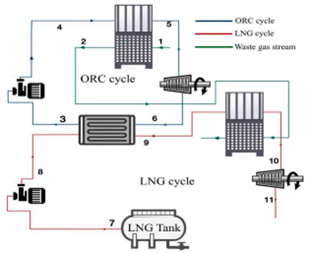
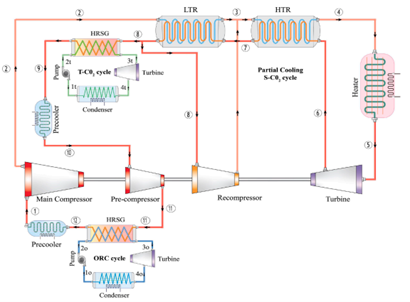
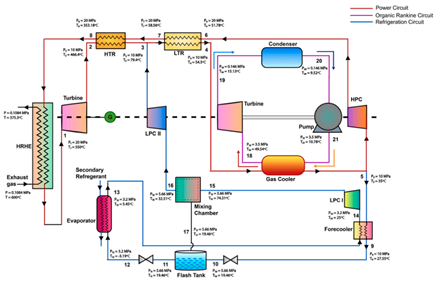
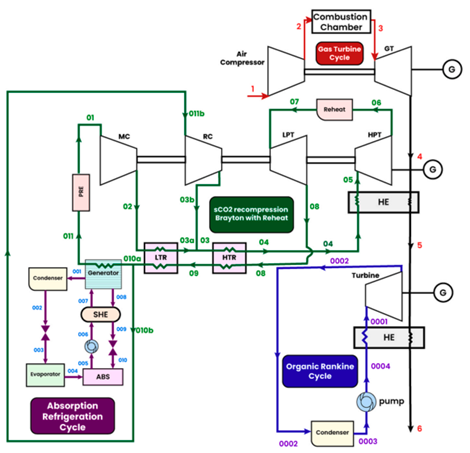
Design and Optimization of Compact Heat Exchanger
Compact heat exchangers are specialized devices designed to facilitate efficient heat transfer between fluids while occupying minimal space. Their design features a high surface-area-to-volume ratio, enabling improved thermal performance in applications with space and weight constraints, such as automotive, aerospace, HVAC, and process industries. The design of compact heat exchangers involves selecting appropriate flow arrangements (e.g., counterflow, crossflow), geometries (e.g., finned surfaces, microchannels), and materials that balance heat transfer efficiency, pressure drop, manufacturability, and cost. Key performance indicators include the heat transfer coefficient, effectiveness, and pressure loss.Optimization of compact heat exchangers aims to achieve maximum thermal performance with minimal energy loss and material usage. This involves multi-objective optimization techniques that consider trade-offs between thermal efficiency, pressure drop, compactness, and cost. Advanced computational tools such as Computational Fluid Dynamics (CFD), along with optimization algorithms and machine learning methods, are commonly used to refine designs.

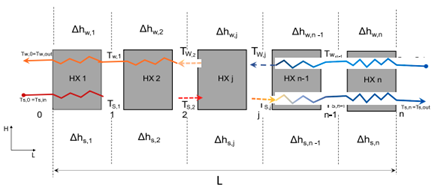

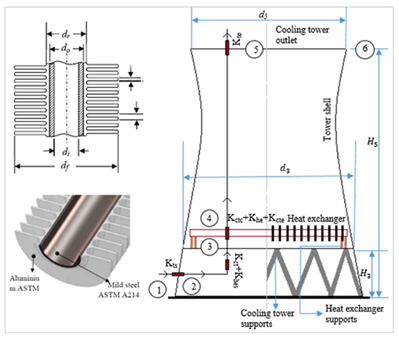
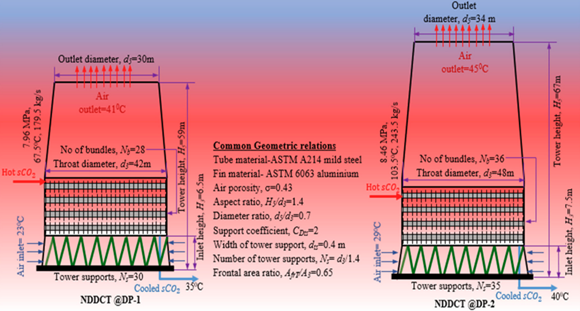
Machine Learning Optimization
Machine learning (ML) has emerged as a powerful tool for optimization in the thermal engineering field, offering data-driven approaches to enhance system performance, reduce energy consumption, and accelerate design processes. Unlike traditional trial-and-error or purely analytical methods, ML algorithms can analyze complex, nonlinear relationships between input parameters and performance metrics. In thermal systems such as heat exchangers, power cycles, refrigeration systems, and multigeneration plants. ML is used for tasks like predicting thermal behavior, identifying optimal design parameters, and conducting multi-objective optimization (e.g., maximizing efficiency while minimizing cost or emissions). Techniques such as artificial neural networks (ANN), support vector machines (SVM), genetic algorithms (GA), and deep learning are frequently employed. By training models on simulation, ML enables rapid evaluation of design alternatives and supports real-time decision-making. This leads to more accurate and efficient optimization compared to conventional methods, especially for systems with complex thermodynamic interactions and large design spaces. Machine learning continues to revolutionize the thermal field by making optimization faster, more reliable, and more adaptable to emerging energy challenges.

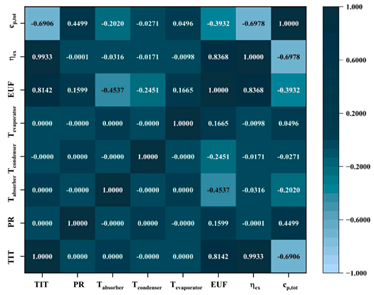

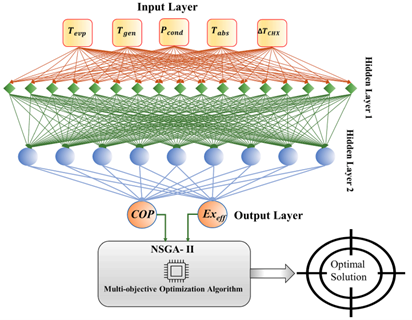
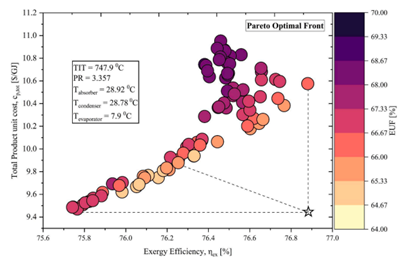

Heat Transfer with Nanofluid
In Sustainable energy, nanotechnology is a prominent mechanism of intensifying the heat transfer performance of working fluid by a stable homogeneous dispersion of solid nanoparticles in a traditional base fluid like water, oil, ethylene glycol, etc. Nanofluid is one of the innovative and inexpensive ways which provides a strong motivation in developing more compact heat exchangers for industrial applications. By the addition of nanoparticles, the thermophysical properties of the working fluid are significantly improved. This engineering project involves the implementation of nanofluid in different engineering applications say for example in the heat exchanger, in different corrugated geometries, and the effect of roughness on nanofluid in terms of heat transfer improvement and pumping power reduction. In this project, a CFD simulation using a finite volume method is employed for the investigation of the hydrodynamic and thermal behavior of nanofluid.

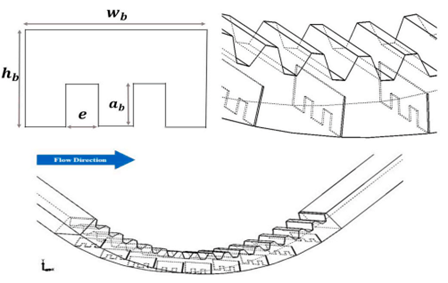
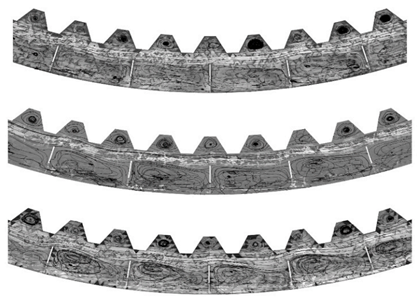
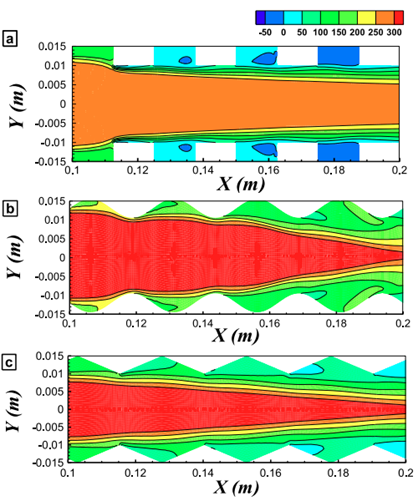
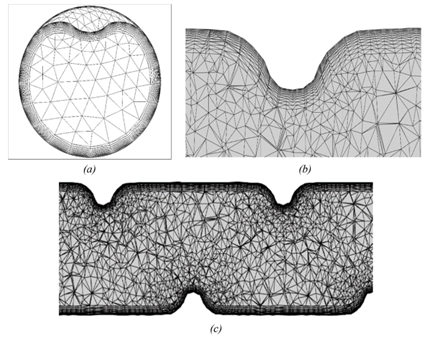
PUBLICATIONS
1. “Thermal analysis of a novel configuration of double effect absorption system cascaded with ejector and injection enhanced compression refrigeration cycle”, Energy Conversion and Management 326 (2025) 119435
Impact factor-11.53, Cite Score-19.1, SJR rank-Q-1
https://www.sciencedirect.com/science/article/pii/S0196890424013761
2. “Multi-Objective Optimization of a Cascaded Supercritical CO2 Brayton Cycle with Ejector-Enhanced Transcritical CO2 and Flash Tank Absorption Refrigeration Cycles” Energy Conversion and Management X (2025) 100988
Impact factor-8.8, Cite Score-7.1, SJR rank-Q-1
https://www.sciencedirect.com/science/article/pii/S2590174525001205
3. “Exergoeconomic Analysis and Multi Objective Optimization of a Nuclear Driven Integrated Cooling and Power Cycle using Response Surface Regression Modeling Coupled with Genetic Algorithm”, Energy Conversion and Management 337 (2025) 119836. Impact factor-11.53, Cite Score-19.1, SJR rank-Q-1
https://www.sciencedirect.com/science/article/pii/S0196890425003590
4. “Advanced exergy analysis and machine learning based multi-objective optimization of a modified triple cascade refrigeration system for enhanced performance”, Applied Thermal Engineering (2025) 126661.
Impact factor-6.1, Cite Score-11.3, SJR rank-Q-1
https://www.sciencedirect.com/science/article/pii/S1359431125012530
5. “Multi-Objective Performance Optimization & Thermodynamic Analysis of Solar Powered Supercritical CO2 Power Cycles Using Machine Learning Methods & Genetic Algorithm” Energy and AI 15 (2024) 100327
Cite Score-11.8, SJR rank-Q-1
https://www.sciencedirect.com/science/article/pii/S266654682300099X
6. “Numerical Assessment of Advanced Thermo-Hydrodynamic Characteristics of Nanofluid inside a Helically Featured Straight Pipe” International Journal of Thermofluids (2024) 100591. Cite Score-9.2, SJR rank-Q-1
https://www.sciencedirect.com/science/article/pii/S2666202724000338
7. “Waste Heat Recuperation in Advanced Supercritical CO2 Power Cycles with Organic Rankine Cycle Integration & Optimization Using Machine Learning Methods” International Journal of Thermofluids (2024) 100612
Cite Score-9.2, SJR rank-Q-1
https://www.sciencedirect.com/science/article/pii/S2666202724000545
8. “Enhancement of thermal power plant performance through solar-assisted feed water heaters: An innovative repowering approach” Energy Conversion and Management: X (2024) 100550. Impact Factor-6.3, SJR rank-Q-1
https://www.sciencedirect.com/science/article/pii/S259017452400028X
9. “Advanced Cascaded Recompression Absorption System Equipped with Ejector and Vapor-Injection Enhanced Vapor Compression Refrigeration System: ANN Based Multi-Objective Optimization” Thermal Science and Engineering Progress (2023): 101745. Impact factor-4.56, Cite Score-7.1, SJR rank-Q-1
https://www.sciencedirect.com/science/article/pii/S2451904924001033
10. “Advanced Thermo-Hydraulic Assessment of Helical Pipes with Different Shapes of Jackets Using Single-Phase and Hybrid Nanofluids” International Journal of Thermofluids (2024) 100628. Cite Score-9.2, SJR rank-Q-1
https://www.sciencedirect.com/science/article/pii/S2666202724000703
11. “Thermal-hydraulic performance and flow phenomenon evaluation of a curved trapezoidal corrugated channel with E-shaped baffles implementing hybrid nanofluid” Heliyon, CellPress, Elsevier. Impact Factor-4, SJR rank-Q-1
https://www.cell.com/action/showPdf?pii=S2405-8440%2824%2904729-7
12. “Machine Learning-Based Multi-Objective Optimization and Thermal Assessment of Supercritical CO2 Rankine Cycles for Gas Turbine Waste Heat Recovery” Energy and AI 15 (2024) 100372. Cite Score-11.8, SJR rank-Q-1
https://www.sciencedirect.com/science/article/pii/S2666546824000387
13. “Thermal Analysis and Dynamic Attributes of a Sustainable CSP-Fossil Hybrid Power Plant Utilizing Organic Rankine Cycles for Enhanced Plant Performance”. International Journal of Thermofluids (2024) 100696
Cite Score-9.2, SJR rank-Q-1
https://www.sciencedirect.com/science/article/pii/S2666202724001381
14. “Multi-Objective Optimization and 4E (Energy, Exergy, Economy, Environmental Impact) Analysis of a Triple Cascade Refrigeration System”. Heliyon, CellPress, Elsevier. Impact Factor-4, SJR rank-Q-1
https://www.sciencedirect.com/science/article/pii/S2405844024076862
15. “Performance Evaluation of Novel Advanced Recompression Absorption Refrigeration Systems Equipped with Ejector and Vapor Injection Technology”, Thermal Science and Engineering Progress (2023): 102773.
Impact factor-5.1, Cite Score-7.2, SJR rank-Q-1
https://www.sciencedirect.com/science/article/pii/S2451904924003913
16. “Genetic Algorithm-based Optimization of Combined Supercritical CO2 Power and Flash-Tank Enhanced Transcritical CO2 Refrigeration Cycle for Shipboard Waste Heat Recuperation”, Energy Reports, Elsevier (2024)
Impact factor-4.7, Cite Score-8.2, SJR rank-Q-1
https://www.sciencedirect.com/science/article/pii/S2352484724004840
17. “Enhancing Thermodynamic Performance with an Advanced Combined Power and Refrigeration cycle with Dual LNG Cold Energy Utilization”. Heliyon, CellPress, Elsevier. Impact Factor-4, SJR rank-Q-1
https://www.sciencedirect.com/science/article/pii/S2405844024117793
18. “Comprehensive Analysis of a Hybrid Solar Assisted Supercritical CO2 Reheat Recompression Brayton Cycle for Enhanced Performance”. International Journal of Thermofluids (2024) 100926. Cite Score-9.2, SJR rank-Q-1
https://www.sciencedirect.com/science/article/pii/S2666202724003665
19. "Thermal Performance Evaluation of a Novel Ejector-Injection Cascade Refrigeration System." Thermal Science and Engineering Progress (2023): 101745. Impact factor-4.56, Cite Score-7.1, SJR rank-Q-1
https://www.sciencedirect.com/science/article/abs/pii/S2451904923000987
20. “Parametric Analysis and Optimization of a Novel Cascade Compression-Absorption Refrigeration System Integrated with a Flash Tank and a Reheater”. Results in Engineering (2023) 101008.
Cite Score-4.5, Impact factor-5, SJR rank-Q-1
https://www.sciencedirect.com/science/article/pii/S2590123023001354
21. “Ejector and Vapor Injection Enhanced Novel Compression-Absorption Cascade Refrigeration Systems: A Thermodynamic Parametric and Refrigerant Analysis”, Energy Conversion and Management 289 (2023): 117190.
Impact factor-11.53, Cite Score-19.1, SJR rank-Q-1
https://www.sciencedirect.com/science/article/abs/pii/S0196890423005368
22. “Thermo-Economic Assessment of Advanced Triple Cascade Refrigeration System Incorporating a Flash Tank and Suction Line Heat Exchanger”, Energy Conversion and Management 295 (2023): 117630.
Impact factor-11.53, Cite Score-19.1, SJR rank-Q-1
https://www.sciencedirect.com/science/article/abs/pii/S0196890423009767
23. "Performance evaluation of an integrated cooling and power system combining supercritical CO2, gas turbine, absorption refrigeration, and organic rankine cycles for waste energy recuperating system." Results in Engineering (2023): 100943. Cite Score-4.5, Impact factor-5, SJR rank-Q-1
https://www.sciencedirect.com/science/article/pii/S2590123023000701
24. "Thermo-Hydrodynamic Performance Evaluation of Double-Dimpled Corrugated Tube Using Single and Hybrid Nanofluids." International Journal of Thermofluids (2023): 100283. Cite Score-9.2, SJR rank-Q-1
https://www.sciencedirect.com/science/article/pii/S2666202723000058
25. “Numerical Assessment of Nanofluids in Corrugated Minichannels: Flow Phenomenon and Advanced Thermo-Hydrodynamic Analysis”. International Journal of Thermofluids 20 (2023) 100426. Cite Score-9.2, SJR rank-Q-1
https://www.sciencedirect.com/science/article/pii/S2666202723001647
26. “Solar energy harvesting from evacuated flat plate collector: Design, thermo-economic analysis, and off design performance”, Results in Engineering 20 (2023): 101461. Cite Score-4.5, Impact factor-5, SJR rank-Q-1
https://www.sciencedirect.com/science/article/pii/S2590123023005881
27. “Cascading the Transcritical CO2 and Organic Rankine Cycles with Supercritical CO2 Cycles for Waste Heat Recovery”, International Journal of Thermofluids (2023) 100508. Cite Score-9.2, SJR rank-Q-1
https://www.sciencedirect.com/science/article/pii/S2666202723002239
28. “Performance Evaluation of a Novel Multigeneration Plant of Cooling, Power, and Seawater Desalination Using Supercritical CO2 Partial Cooling, ME-TVC Desalination, and Absorption Refrigeration Cycles” Energy Conversion and Management: X 20 (2023) 100485. Impact factor-6.3, Cite Score-5.9, SJR rank-Q-1
https://www.sciencedirect.com/science/article/pii/S2590174523001411
29. “Thermodynamic assessment of a triple cascade refrigeration system utilizing hydrocarbon refrigerants for ultra-low temperature applications" Energy Conversion and Management: X 14 (2022): 100207. Cite Score-5.9, SJR rank-Q-1
https://www.sciencedirect.com/science/article/pii/S2590174522000307
30. " Thermal Assessment and Optimization of Process Fluids in Transcritical Organic and Transcritical CO2 Rankine Cycle for Waste Energy Recuperating System" Energy Conversion and Management: X (2022): 100258.
Cite Score-5.9, SJR rank-Q-1
https://www.sciencedirect.com/science/article/pii/S2590174522000812
31. “A Comprehensive Thermodynamic Assessment of Cascade Refrigeration System Utilizing Low GWP Hydrocarbon Refrigerants." International Journal of Thermofluids (2022): 100177. Cite Score-9.2, SJR rank-Q-1
https://www.sciencedirect.com/science/article/pii/S2666202722000416
32. “Energy, Exergy, Exergoeconomic, and environmental (4E) analyses of thermal power plants for municipal solid waste to energy application in Bangladesh”. Waste Management 134 (2021):136-148.
Impact Factor -8.81, Cite Score-15.1, SJR rank-Q-1
https://www.sciencedirect.com/science/article/pii/S0956053X21004311
33. “Numerical Investigation of a modified Kalina cycle system for high-temperature application and genetic algorithm-based optimization of the multi-phase expander’s inlet condition”, Energy and AI 6 (2021) 100117.
Cite Score-11.8, SJR rank-Q-1
https://www.sciencedirect.com/science/article/pii/S2666546821000665
34. “Analysis and optimization of a modified Kalina cycle system for low-grade heat utilization”, Energy Conversion and Management: X 12(2021) 100121. Cite Score-5.9, SJR rank-Q-1
https://www.sciencedirect.com/science/article/pii/S2590174521000465

